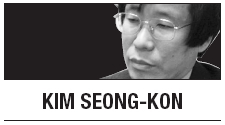An outsider’s perspective is often illuminating and enlightening, as he or she perceives the world differently from us, and sees things that insiders tend to miss. While an outsider’s views are fresh and penetrating, an insider’s vision is often banal and myopic. In Korea, for example, the famous short story,

“Kapitan Lee,” is widely known as an account of an opportunistic doctor who manages to survive Korea’s turbulent years of the Japanese occupation, and the liberation and division of the country. Koreans think of Dr. Lee as a chameleon-like person who is selfish and egotistic, for he adapts to new environments quickly, and prospers when others fall into misery. At school, therefore, Korean students learn that Dr. Lee is someone whom they should never emulate as a role model.
Surprisingly, however, American students interpret Dr. Lee’s character quite differently. When I taught at Brigham Young University a dozen years ago, I assigned the English translations of Korean literature to my students and asked them to write a response paper. A student named Michael Keller submitted a paper saturated with a whole new perspective on Chon Kwang-yong’s “Kapitan Lee.” To my surprise, Keller asserted the opposite of what most Koreans believe. “Dr. Lee,” he wrote, “is in fact an extremely able man who knows how to survive in times of crisis.”
During the Japanese occupation of Korea, for example, Dr. Lee studies the Japanese language diligently to communicate with Japanese officials in the colonial government. When the Soviet troops enter Korea from the north after the liberation, Dr. Lee studies Russian in order to get to know the Soviet military officers who are fond of him, giving him the nickname, “Kapitan Lee.” After he comes down to the south, which is under U.S. military rule, Dr. Lee begins studying English to get along with the Americans.
According to Keller, Dr. Lee tries very hard to cope with the harsh reality, while others simply despair or give up. The Korean government fails its people, and yet, Dr. Lee not only survives, but also thrives. If so, Keller argues, we have no right to condemn or blame him. Unlike Koreans who tend to easily condemn someone if he defies social norms, Keller, as a practical American, found it unfair to criticize Dr. Lee. While defending him, Keller provided a fresh take on Dr. Lee’s seemingly egotistic survival tactics.
Recently, I had the opportunity to read reviews of Korean folktales written by American students, as a judge for an essay contest. I was once again intrigued by the diverse outsiders’ perspectives found in the essays. For example, while reviewing, “The Heavenly Maiden and the Woodcutter,” an American student argued that the woodcutter should not have stolen the heavenly maiden’s dress since theft is morally wrong. Furthermore, the deer had no right to put the heavenly maiden in misery. The American continued, “The importance of this story is to teach people to treat others how they would like to be treated. Don’t take advantage of people because it never leads to anything good, for yourself or the other person.” This response seemed to represent the legalistic American way of thinking.
Another reviewer read the same folktale in a different and interesting light. He argued that the woodcutter lost everything in the end because he let his emotions rule him; the essayist remarked, “One should use one’s mind to make decisions, not one’s heart. Emotions are mankind’s fatal flaw.” This response also seemed to well represent the rationalist streak in American thinking.
While reading “The Queen Shallow’s Gift,” another American student found the story unfair. He wrote: “Hung-bu should have stood up for himself and told his brother Nol-bu that they are equals. Everyone should be treated equally and not have to be treated badly by others.” The reviewer was discontent with the attitude of Hung-bu and wrote, “I don’t understand why you put yourself at someone’s mercy, especially someone who treats you so badly.” I chuckled at the reviewer’s naivet, but the above opinion surely reflected the American way of living.
Reviewing “Simchong: the Blind Man’s Daughter,” another American student pointed out that since Simchong’s father was an inconsiderate liar who falsely promised to donate 300 bags of rice to the temple, he was not supposed to regain his daughter or sight. In addition, the essayist also remarked that the monk who suggested such a large donation was not a good person. Responding to “The Green Frog,” an American reviewer came up with the following intriguing idea; the disobedient green frog was, in fact, unique and creative. But the mother could not see this and lamented: “Why can’t he be like other frogs?”
Although outsiders’ perspectives may not be quite right at times, they always shed light and provide insight, allowing us to reevaluate the conventional interpretations of our literature and folktales. In order to prevent our own understanding and knowledge from growing stale and myopic, we should endeavor to consider outsiders’ opinions and view all things from multiple angles.
By Kim Seong-kon
Kim Seong-kon is a professor of English at Seoul National University and director of the Korea Literature Translation Institute. ― Ed.








